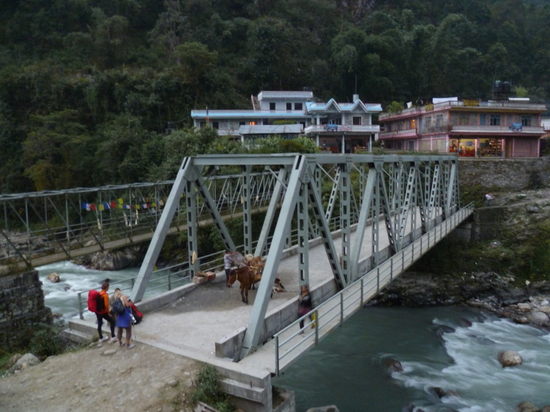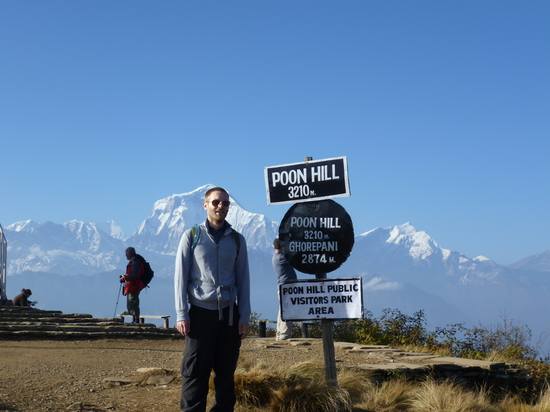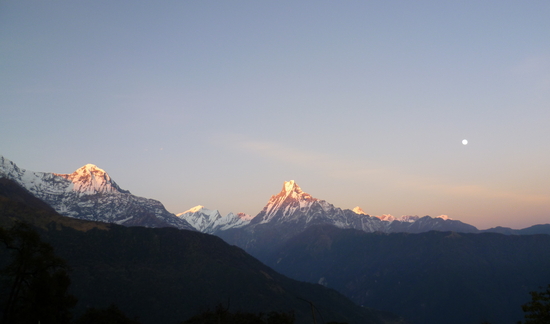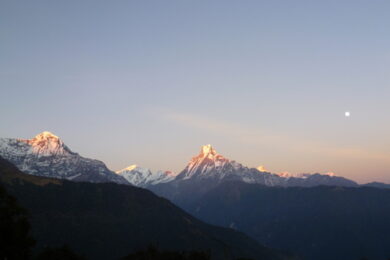“Together we knew toil, joy and pain. My fervent wish is that the nine of us who were united in the face of death should remain fraternally united for life.” – Maurice Herzog, the first man ever to reach the summit of Annapurna I, writing from his hospital bed in 1951.
Part 1: Poon Hill
=========
Unlike Maurice Herzog, our objective is not the summit of Annapurna I. Ours, rather more modestly, is Annapurna Base Camp, where Herzog and subsequent demented mountaineers have passed through on their way to death or glory. Set in the Nepali Himalayas, ABC is at the base of an almost comically beautiful panorama, dotted with 6,000, 7,000 and 8,000-metre peaks, the concentration of which one cannot easily experience anywhere else in the world. It is the jewel of the Annapurna Sanctuary, a vast conservation area that claims lives as well as well as enriches them. Our endpoint is only 4,130 metres high rather than Herzog’s 8,091, but getting even halfway is trouble enough.
Before you even think about lacing up your boots, there are serious considerations. Altitude is one. Altitude sickness can affect anyone from about 2,000m upwards, and can be totally random. Loosely speaking, it’s more likely to affect men in their twenties as they confidently trot up the jungle paths to impress their girlfriends, but it can give even the hardiest peak-hopper a woolly head and intense lethargy. Temperatures are less of an issue for us, trekking in November. Daytime temperatures hover anywhere between 10 and 20 degrees, but as soon as the sun drops behind the mountains the mercury drops with it, at its worst bottoming out at around -13. The lodges dotted around the mountains that we’re booked to stay in have no heating, making anything less than a four-season sleeping bag essentially an ice cube tray. Aside from that, the general lack of clean water, the proliferation of non-flushing porcelain holes in the ground instead of toilets and the lack of any cheese apart from nak (meaning female yak) are all potential stumbling blocks. And that’s before you’ve even left the hotel.
As it happens, our hotel in the capital, Kathmandu, is full of trekkers intending to go to Everest Base Camp, a few mountains over from the Annapurna range. However, the combination of poor weather and one of the world’s most dangerous airports, Lukla, has ensured a backlog of anxious travellers crowding in reception. Not only can they not get out to the start-point for their trek, the people already out there can’t get back. Later in our trek, we hear word of panicked tourists selling their digital cameras and watches to locals so that they can keep on paying for their lodgings and food. Some even attempt the treacherous and hungry five-day walk back to the next airport in Pokhara, so unlikely is it that planes will be able to land at Lukla. Thankfully, we’re driving rather than flying to Pokhara to begin our trek.
And that’s where the problems kick off for us. The eight-hour bus journey from Kathmandu to Pokhara is among the more terrifying things that I’ve ever experienced (and, I since discovered, was the subject of a BBC documentary entitled The World’s Most Dangerous Roads). Traffic isn’t the problem so much as the blind, telepathic understanding you have to rely on to avoid other vehicles and the sheer drops on either side, promising a scree-scuffed death should you plummet over. Horns that sound like whole movements of Steve Reich minimalist panoply condensed into half-second bursts ensure that sleep is impossible, as does the quality of the road itself. Squirming through gaps between lorries full of goats while Ken Kesey-style caravan-cum-buses hare at you in the other direction turns the enormous front windshield into a cinema screen playing a psychedelic version of Spielberg’s Duel. We trundle past huge crowds of villagers carrying their dead on funeral pyres, past elaborately embellished graffiti on vans that cheeringly display swastikas (a Hindu peace symbol) and positive messages like "Speed King!", "Missing you already!" and "King Of The Road!" More than one mistakenly reads "Road Of The King!"
Eventually, after a lot of squealing of brakes, we pass Pokhara and arrive at our starting point, Birenthanti. The sense of calm in this place, with its beautiful, fast-flowing river and reassuringly solid steel bridge crossing it, is short-lived. Locals queue up to dump their rubbish in the river, and the bridge actually leads directly into a cliff face. Apparently the locals are debating whether or not to make it road-accessible. Children approach us, crying “Give me sweets!” or “Give me money!” and we’re told by our guides to ignore them.

The next day, after a surprisingly effective and restful sleep, we leave Birenthanti and begin our ascent. In the morning, I discover that I have essentially brought with me only one pair of walking trousers. I purchased two on the assumption that I could swap them over from day to day but the fools at Sports Direct in Camden have neglected to remove a security tag that, due to its positioning, could leave my testicles either covered in anti-theft paint or severely lopsided. So that’s ten solid days of trekking with one pair of trousers. I am one of those thrill-seeking idiots who kicks an Alsatian to make his mates laugh, only to have his foot bitten clean off. I pack the bollock-wrenchers at the bottom of my bag.
We walk through the town of Ulleri with its plump, plentiful chickens and corrugated shacks, and then climb 3,300 stone steps of varying stability. Our total ascent for the day will take us to about 2,800 metres which, rather pleasingly, is well over half of our total height. However, this is the half that doesn’t give you headaches and temporary dementia. That’s still to come. As we ascend, our first glimpse of the mountain range we’re aiming at is obscured by cloud. We climb listlessly, unaware of what majesty could be passing us on all sides. We reach Banthanthi, our lodge, and are teased with a partial lifting of cloud, meaning we can see that there are mountains up there somewhere. But where?
The lift in cloud is just about enough for us to see the barest glimpse of Machapuchare. Known as the fish-tail mountain thanks to its piscine silhouette, is at the edge of the range we’re aiming for and gives us a goal. Our guide tells us of the mountain’s sacred status as we sit in the sunshine. Of particular significance to Nepal’s Buddhist population, it has never been summited, despite being a good 1,200 metres lower than its neighbouring giants. Two climbers attempted it in the fifties, but only got to within 50 metres from the summit. Storms came and washed two villages clean off the mountainside. Any summit attempt is now forbidden by law.
Tomorrow morning, we’re due to ascend Poon Hill at the rippingly optimistic hour of 5AM to catch the sunrise. A local beauty spot and the first proper chance to see the Annapurna range in its misty glory, its peak is a rather innocuous-sounding 3,210 metres. We’re about four hundred below that currently, and we’ve arrived at Banthanti ahead of schedule. A quick afternoon trot up to see what the fuss is about and beat the morning tourists is a good idea, isn’t it? Yeah? Just mosey on up and drink in that view, mmm-hmmm! Our guide says it’s a great afternoon for it, but he’s off duty for the rest of the day, so we’ll have to go up alone. My stomach is feeling a little bit tender, probably from the odd bit of dodgy water and crapping into holes in the floor, but I’m not missing out on this. Our first proper look at Herzog’s peak, the forbidden fish-tail and all the others is too tempting.
Progress is sunny, even springy at first. Scampering up with what people nowadays call ‘banter’ aplenty, it’s a breeze for the first ten minutes. The hillside is decked with flora of varying vivacity, dainty little flowers braving the crisp winter air for a chance of soaking up some light. Gradually, the group elongates in its track up the hill. I can’t speak for anyone else, but my chest has taken on some serious weight by this point. Not wishing to be the first to say anything, however, it seems best to press on and forget about it. Eventually, when the chest ache heads northwards, the best I can manage is a gasping, "Can you feel the altitude yet?" to my girlfriend. Though I’m not the only one, I certainly feel the weakest. We drop back a few places and take it steady. As any good mountaineering book will tell you, the only way to combat altitude sickness is to drink loads of water and go down the hill as soon as you can. So we sensibly continue on upwards and try to ignore the fact that our camel-baks are close to empty.

The summit, when it comes after nearly an hour of trudge, is not spectacular enough to double the size of my lungs and make me turn cartwheels in my longjohns, but it’s certainly something. Woolly-headed and not improving, I stagger about the top of the hill, peering at the far-off majesty of the Annapurnas. This is the first time we’ve seen them all together. We tick them off like the Von-Trappe children before bed, pleased with ourselves for having gotten this far without keeling over. I forget that we’re doing this again in the morning.
Night comes, and the temperature drops. After dinner, I become aware of some curious gut-rumbling. I’ve eaten a few lip-melting pickles with my dhal bat, so I tell myself it’s probably nothing to worry about. However, as I settle into my sleeping bag, some sort of battle erupts in my stomach. The churning is incredible. A fly buzzes dozily in the corner of the sparse bedroom, occasionally bonking into the dim bulb, so I try and concentrate on it. Very soon, I hate the fly. Outside, some Polish trekkers carouse aided by the local Khukri rum. The next room to ours sounds like it’s occupied by Mike Oldfield. I drift in and out of consciousness, scared back into waking by dreams of my own belly as a Giger-esque intestinal masterwork. In a daze, I put on Nick Drake’s Pink Moon and try to forget.
Only after the rain comes the rainbow, and only after a night of clutching your stomach in agony comes the Himalayan mountain view. The second ascent of Poon Hill is a comparative cakewalk – nay, an excitable gallop – lit by headtorches. Unfortunately, I’m not ready to be a person who owns a headtorch at this stage of my life, so I use a normal one. The sun rises as we reach the top, and we sit quietly among the prayer flags as the other tourists mill around. It is, frankly, enough to make you not want to walk down again. But walk down we must. We breakfast in front of the barest glimpse of Machapuchare, the fish-tail mountain, with spirits immeasurably higher. The next few days will see us jettison half of our equipment, edging closer to the Annapurna Sanctuary, to ABC and heights as yet unscaled by us. Herzog’s peak is coming.



